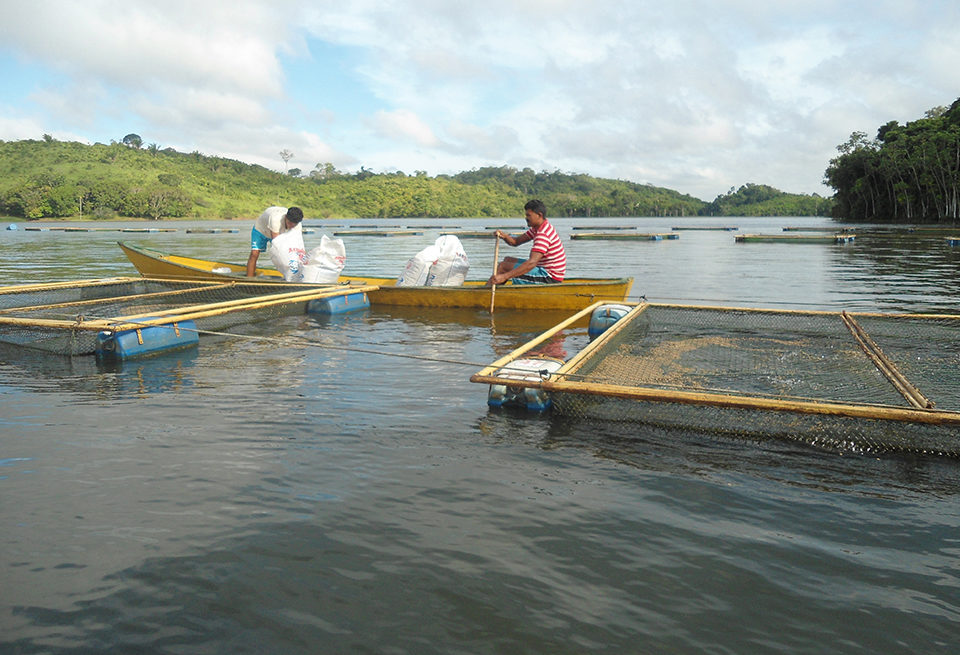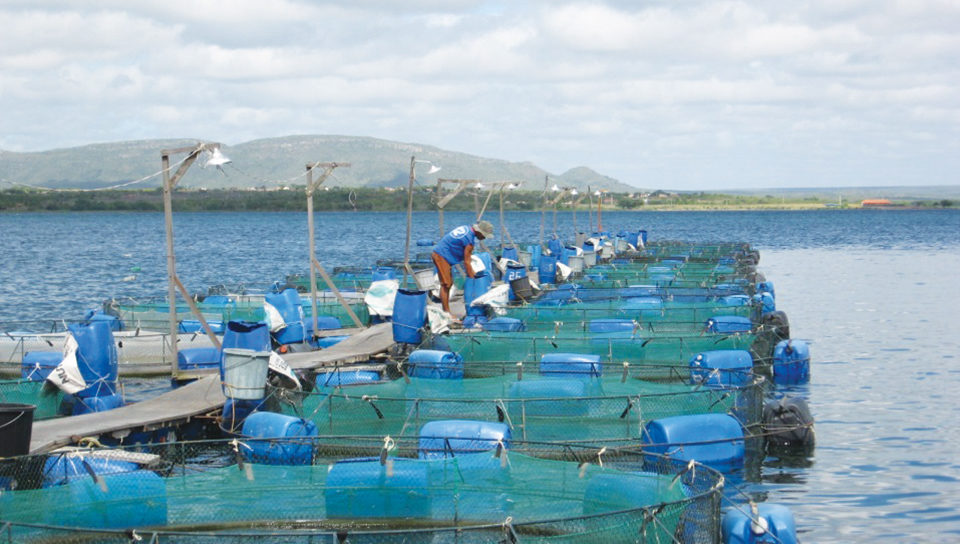Tilapia production will lead the way

Aquaculture in Brazilian federal waters is worth around 3.0 billion Brazilian reals (U.S. $987.4 million) in business and provides a million direct and indirect jobs, and feed production around 900 million metric tons (MMT) annually. According to the Brazilian Ministry of Fisheries Aquaculture Institute of Geography and Statistics, this agribusiness produced around 476,000 MT in 2013, representing a growth rate of 56 percent in the past 12 years. Thus, the aquaculture industry is consolidating as the main source for fisheries production, a trend observed in other countries of the world, like China, Norway and Chile.
The Brazilian Institute of Geography and Statistics reported that among the species produced in the country, freshwater fish such as tilapia, Oreochromis niloticus, accounted for 43.0 percent of the Brazilian aquaculture production in 2013. Farming of tambaqui, Colossoma macropomum, reflected 22.6 percent, and the hybrid “tambacu” (female C. macropomum x male Piaractus mesopotamicus) made up 15.4 percent of the production. Still, other species have potential to be produced on a large scale, mainly due to their wide acceptance by consumers. These include arapaima, Arapaima gigas; surubins, the spotted catfish Pseudoplatystoma corruscans; and cachara, Pseudoplatystoma fasciatum. However, these species still require further research and development of specific technologies for production on a commercial scale, which happened earlier for tilapia.
Aquaculture In Federal Waters
The current annual world fish production is estimated at 158 MMT, and according to United Nations Food and Agriculture Organization projections for 2030, it is expected to increase around 100 MMT/year. With an estimated potential annual yield of 20 MMT, Brazil could help to meet this demand.
Given these projections, Brazil’s federal government – with the participation of the production sector and civil organizations – drafted the sustainable development plan entitled “More Fishing and Aquaculture” in 2008. The objective of the plan was to promote the sustainable development of fisheries and aquaculture by linking all those involved with the sectors, thus consolidating sustainable state development policies addressing social inclusion, security and food sovereignty in Brazil.
The use of reservoirs for multiple uses, including aquaculture, in Brazil was established by the National Water Resources Policy act in 1997. This legal framework was complemented by federal directives regulating the use of Brazilian waters and public spaces for the practice of aquaculture. Up to 1 percent of the area of federal waters is available for aquaculture, which corresponds to at least 55,000 ha in freshwater reservoirs.
Reservoir studies
A key strategy of the More Fishing and Aquaculture plan is the development of aquaculture in federal waters. Therefore, the Ministry of Fisheries and Aquaculture has invested in studies for the demarcation of aquaculture parks in many reservoirs, as well as the coastal areas of Santa Catarina and Paraná.
These studies were based on criteria that addressed issues of environmental, social and economic sustainability. These 10 reservoirs have potential for the implementation of 100 aquaculture parks with a total area over 1,920 hectares for fish culture and production capacity estimated at 227,000 MT/year of fish. This number would rise to more than 284,000 MT if the two studies in coastal areas are included (Table 1).
Roubach, Estimated production for demarcated aquaculture parks, Table 1
| Area | Reservoir/State | State | Estimated Production (mt/year) | Most Important Species |
|---|---|---|---|---|
| Reservoir | Furnas | Minas Gerais | 35,702 | Oreochromis niloticus |
| Reservoir | Três Marias | Minas Gerais | 25,748 | Oreochromis niloticus |
| Reservoir | Ilha Solteira | Mato Grosso do Sul/ São Paulo/ Minas Gerais | 50,422 | Oreochromis niloticus |
| Reservoir | Castanhão | Ceará | 33,080 | Oreochromis niloticus |
| Reservoir | Itaipu | Itaipu | 2,920 | Piaractus mesopotamicus |
| Reservoir | Tucuruí | Pará | 8,518 | Piaractus brachypomus |
| Reservoir | Lajeado | Tocantins | 21,856 | Colossoma macropomum |
| Reservoir | Serra da Mesa | Goiás | 31,356 | Oreochromis niloticus |
| Reservoir | Cana Brava | Goiás | 10,140 | Oreochromis niloticus |
| Reservoir | Manso | Mato Grosso | 7,192 | Piaractus mesopotamicus |
| Coastal | Santa Catarina | Santa Catarina | 306 | Crassostrea gigas, Perna perna, Nodipecten nodosus |
| Coastal | Paraná | Paraná | 57,538 | Crassostrea rizophora |
| Total | – | – | 284,778 | – |
Currently, studies are being finalized and/or aquaculture parks are being implemented in 36 reservoirs: five in the Midwest, eight in the Northeast, five in the North, eight in the Southeast and 10 in the South. This development represents at least 210 parks. Of these, about 100 will be allocated to aquaculture on a family scale.
Furthermore, in recent years, studies have been conducted to set up additional marine aquaculture parks in several states where parks for the production of fish, oysters, scallops, mussels and algae are already occupied by producers/entrepreneurs. The parks already identified may contribute increases of 59 percent over the current national aquaculture production and 37 percent in the present national fisheries production.
Carrying capacity
The granting of permission to use freshwater bodies for aquaculture projects in Brazil is carried out by the National Water Agency, which sets the maximum permissible value of fish in a given reservoir by calculating the carrying capacity using the hydrodynamic model developed by Peter J. Dillon and Frank H. Rigler in 1974. However, new research and pilot projects are being developed by University of Brasilia with Guelph University under a collaborative project involving the Brazilian Ministry of Science and Technology’s National Council for Scientific and Technological Development, and International Science and Technology Partnerships Canada to improve the methodology and input data through the integration of a nutritional bioenergetics model described by C. Young Cho and Dominique P. Bureau in 1998.
The hydrodynamic model projects waste dispersion simulations for the use of commercial diets with different total phosphorus percentage. This model allows more compartmentalized analysis of aquaculture parks, assigning technical, environmental and nutritional aspects for each region and increasing the security and reliability of estimates of environmental carrying capacity.
To enable the safe and environmentally responsible implementation of aquaculture in federal waters, mechanisms will be established to support supervised management of fish culture areas and define maximum productivity indicators, safe phosphorus levels in feed and distances between culture areas to allow appropriate dilution of waste in the environment.

Aquaculture potential, challenges
Brazil is a country with great climatic diversity, great species diversity and an abundance of water resources for the development of aquaculture in federal waters. Aquaculture activity in lakes and reservoirs has expanded in the last 10 years, and hence the volume of projects and farms registered by the Ministry of Fisheries and Aquaculture.
However, despite this potential, there are a number of challenges to overcome for consolidation of the Brazilian aquaculture program. The main challenges are the lack of standardization of environmental licensing procedures across the states of the federation, bureaucracy and the limited preparation of environmental agencies to review projects and issue environmental licenses.

These problems have increased the risk of investment in aquaculture, especially when factors such as global climate change, localized water scarcity and depletion of reservoirs, eutrophication and animal health problems are also considered.
An important point to examine is the absence of specific biosafety and health policies for aquaculture in federal waters, since the aquaculture parks program groups together entrepreneurs, family farmers and government projects with different objectives and different degrees of knowledge and concern. Thus, there is a need to implement management committees and programs for monitoring and control of the reservoirs and the Brazilian coast.
Finally, integrated and sustainable development of the production chain in these regions – with tax exemption in the acquisition of supplies and equipment – is needed, along with coordination across the production chain to minimize the economic, social and environmental risks of these projects in Brazilian federal waters.
(Editor’s Note: This article was originally published in the July/August 2015 print edition of the Global Aquaculture Advocate.)
Authors
-
Rodrigo Roubach, Ph.D.
Ministry of Fisheries and Aquaculture
SBS Quadra 02, Lote 10
Bloco J, Edificio Carlton Tower
Brasília, Distrito Federal, Brazil[114,98,46,118,111,103,46,97,112,109,64,104,99,97,98,117,111,114,46,111,103,105,114,100,111,114]
-
Antônio Ostrensky, Ph.D.
Department of Animal Science
Federal University of Paraná
Curitiba, Paraná, Brazil -
Eduardo Pickler Schulter
EPS Aquaculture and Environment
-
Dr. Guilherme Wolff Bueno
Department of Animal Science
University of Brasília
Campus Universitário Darcy Ribeiro
Brasília, Distrito Federal, Brazil
Tagged With
Related Posts

Innovation & Investment
Brazil study results encouraging for injector
Zero-exchange biofloc systems allow elevated stocking densities and production, but also require more dissolved oxygen and thorough water circulation. A new type of air injector uses only a centrifugal pump to recirculate water while naturally aspirating ambient air.

Intelligence
Brazilian aquaculture: Constraints and challenges (Part 1)
The Brazilian aquaculture industry has been growing steadily during the last two decades. Despite facing a number of challenges it is looking at continued growth and a larger role in the export markets.

Intelligence
Brazilian aquaculture: Constraints and challenges (Part 2)
Brazil will have to deal with an adverse economic and political environment in the next few years. One should expect high value fish products like shrimp, tilapia, Chilean salmon and cod being replaced by more affordable seafood and alternative meats, as consumers keep losing purchasing power due to inflation, unemployment and monetary devaluation.

Innovation & Investment
Caribbean producer aims to make a name for sutchi
Pangasius farmed in the Dominican Republic? True story. Value Aquaculture, with partners hailing from Germany and Chile, is trying to get U.S. buyers to take a fresh look at the Mekong catfish species.


